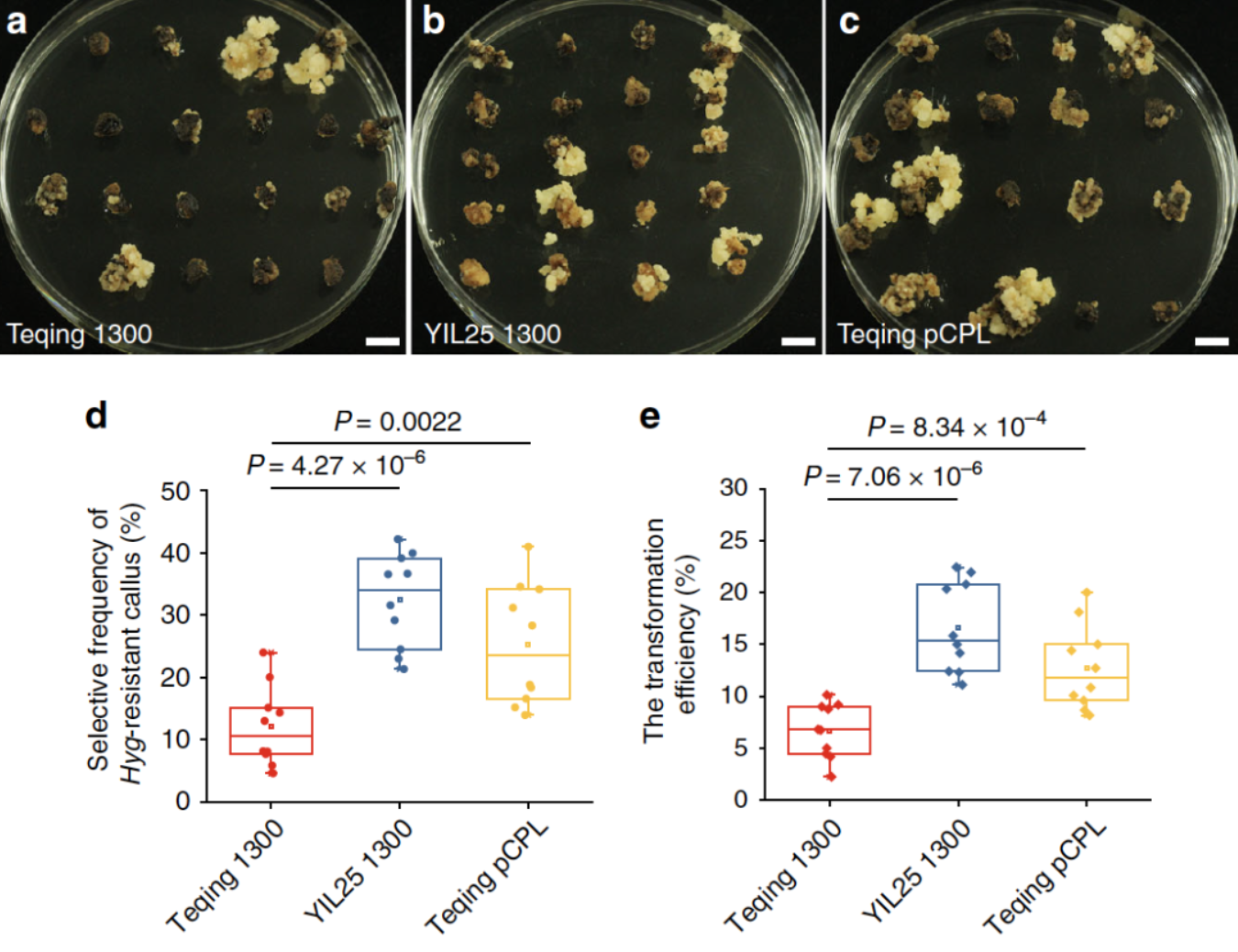博文
Nature Communications:水稻基因BOC1作用于愈伤褐化
||
A rice gene BOC1 functions in callus browning
Background: Callus browning, a common problem in plant vitro culture, greatly decreases the regeneration rate and genetic transformation efficiency. The browning process is mainly caused by the enzymatic oxidation of phenols to quinones by polyphenol oxidase (PPO), following by the polymerization which produces the brown products. Thus, antioxidants (vitamin C) and adsorbing agents (activated carbon), as well as low salt medium, are normally used to inhibit callus browning during tissue culture.
Question: However, there is no universal solution and potential molecular regulatory mechanisms has been largely unclear.
Findings: Here, Zhang et al (2020) report that a rice gene, BROWNING OF CALLUS1 (BOC1), functions in alleviating callus browning. First, authors construct a set of introgression lines using a wild rice Yuanjiang as a donor that is resistant to callus browning and an elite indica cultivar Teqing as a recipient that is susceptible to callus browning and screened the introgression line YIL25 which is relatively resistant to callus browning. Next, authors construct a F2 segregation population and identify the causal gene LOC_Os03g12820 by QTL mapping using SSR markers and a high-resolution mapping using SNP markers. Knockdown of this gene in YIL25 and complementary assays in Teqing suggest that LOC_Os03g12820 is BOC1 that regulates callus browning in rice. However, overexpression of BOC1 in Teqing causes serious callus browning, indicating only the appropriate expression of BOC1 can reduce callus browning.

Functional analysis of BOC1.
Meanwhile, authors find Teqing and YIL25 have the exactly same coding sequences of BOC1, implying a potential divergence in gene expression. Indeed, RT-qPCR and RNA in situ hybridization show that BOC1 is transcriptionally induced by subculture and much stronger in YIL25 than in Teqing. Five types of variations exist between YIL25 and Teqing in promoter regions and the 337bp insertion, a Tourist MITE transposon, in YIL25 is proved to be associated with the stronger transcriptional response of BOC1 to subculture using luciferase reporter system. Physiological and biochemical indices and RNA-seq analysis show that BOC1 reduces callus browning via alleviating the oxidative stress. Finally, authors propose that the sequence variation in the BOC1 promoter influences callus browning by affecting BOC1 expression based on population data.

Transcriptional characterization of BOC1.
Conclusion: Overall, authors find that the insertion of a TE element in the promoter region of BOC1in wild rice leads to the stronger transcriptional response compared with the elite cultivar. The appropriate expression of BOC1 reduces callus browning via alleviating the oxidative stress. Importantly, BOC1 improves the genetic transformation efficiency of rice by reducing callus browning during Agrobacterium-mediated transformation. These findings provide a gene target for improving tissue culture regeneration system and increasing genetic transformation efficiency, thus facilitating the molecular breeding of rice.

BOC1 influences genetic transformation efficiency.
水稻基因BOC1作用于愈伤褐化
背景回顾: 愈伤褐化是植物离体培养培养中的一个常见问题,通常会导致再生速率和遗传转化效率的降低。褐化过程主要是酚类化合物被多酚氧化酶PPO氧化成醌类化合物,后者会进一步聚合为褐色物质。因此,在植物组织培养中,通常会加入维生素C或者活性炭等吸附剂来抑制愈伤的褐化。
科学问题: 但是,目前仍没有一个通用的解决方案。另外,愈伤褐化潜在的分子调控机制仍不清楚。
研究发现: Zhang等人于2020年首次报道了一个水稻基因BOC1作用于愈伤褐化的缓解。首先,作者利用不易产生愈伤褐化的野生稻‘元江’为供体,容易产生愈伤褐化的栽培稻‘特青’为受体,创制了一系列的基因渐滲系,然后筛选出了对愈伤褐化颇具抗性的YIL25。接着,作者利用YIL25与‘特青’杂交产生的F1代,创制了子代出现表型分离的F2代,然后通过基于SSR标记的QTL作图和基于SNP标记的精细作图鉴定到了与愈伤褐化关联的目的基因LOC_Os03g12820。通过敲低YIL25中LOC_Os03g12820基因的表达,以及在‘特青’中互补YIL25的LOC_Os03g12820基因表达,确定了该基因就是BOC1基因,作用于水稻中的愈伤褐化调节。但是,在‘特青’中过表达BOC1基因也会导致愈伤出现严重的褐化表型,说明只有BOC1基因的表达量处于一个合适的水平,才能够减少愈伤褐化。
同时,作者发现‘特青’和YIL25的BOC1基因序列一模一样,暗示着‘特青’和YIL25中BOC1基因的分化可能是在转录水平。的确,作者通过RT-qPCR和RNA原位杂交发现,BOC1基因受到愈伤继代培养的诱导,并且在YIL25中的表达响应显著比‘特青’中的高。在YIL25和‘特青’BOC1基因上游的启动子序列中,作者共鉴定到了5处变异类型。利用LUC报告系统,作者进一步发现其中一处由Tourist MITE转座子插入导致的变异,是导致YIL25中BOC1基因高强度响应愈伤继代的关键因素。后续一系列的生理和生化指标检测以及转录组数据分析显示,BOC1能够通过缓解氧化应激胁迫来减少愈伤褐化。最后,作者基于群体数据,发现BOC1基因启动子序列上的变异与其表达水平相关,从而影响愈伤褐化。
总结展望: 综上,作者发现野生稻BOC1基因启动子上一个TE元件的插入导致其要比栽培稻在响应愈伤继代培养时的表达更强。而BOC1基因合适的表达水平通过减缓氧化应激胁迫,减少了愈伤褐化。重要的是,作者发现BOC1基因能够减少农杆菌介导的遗传转化过程中的愈伤褐化,从而提高遗传转化效率。本文的研究发现为组织培养再生体系的改良和遗传转化效率的提升提供了候选靶基因,有助于加速水稻的分子育种。
Reference
Zhang, K., Su, J., Xu, M. et al. A common wild rice-derived BOC1 allele reduces callus browning in indica rice transformation. Nature Communications, 2020, 11: 443.
https://m.sciencenet.cn/blog-3158122-1361707.html
上一篇:Nature Communications:植物通过RNA G-四链体来促进低温适应
下一篇:Nature:生长素受体TIR1/AFB的腺苷酸环化酶活性
全部作者的其他最新博文
- • Plant Physiology:CsMADS3促进柑果中的叶绿素降解和类胡萝卜素合成(华中农业大学)
- • Molecular Plant:LBD11-ROS反馈调节作用于拟南芥的维管形成层增殖和次生生长(浦项科技大学)
- • Science Advances:根结线虫通过调控植物的CLE3-CLV1模块,促进侵染进程(日本熊本大学)
- • The Plant Cell:拟南芥P小体组分通过对FLC的转录调控,影响开花时间(安徽农业大学)
- • Nature Communications:油菜素内酯参与植物营养生长期转变的分子机制解析(浙江农林大学)
- • Current Biology:光合作用产生的蔗糖驱动侧根“生物钟”(德国弗莱堡大学)